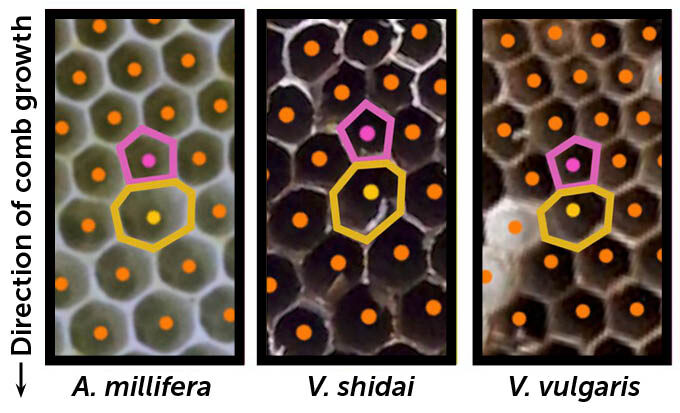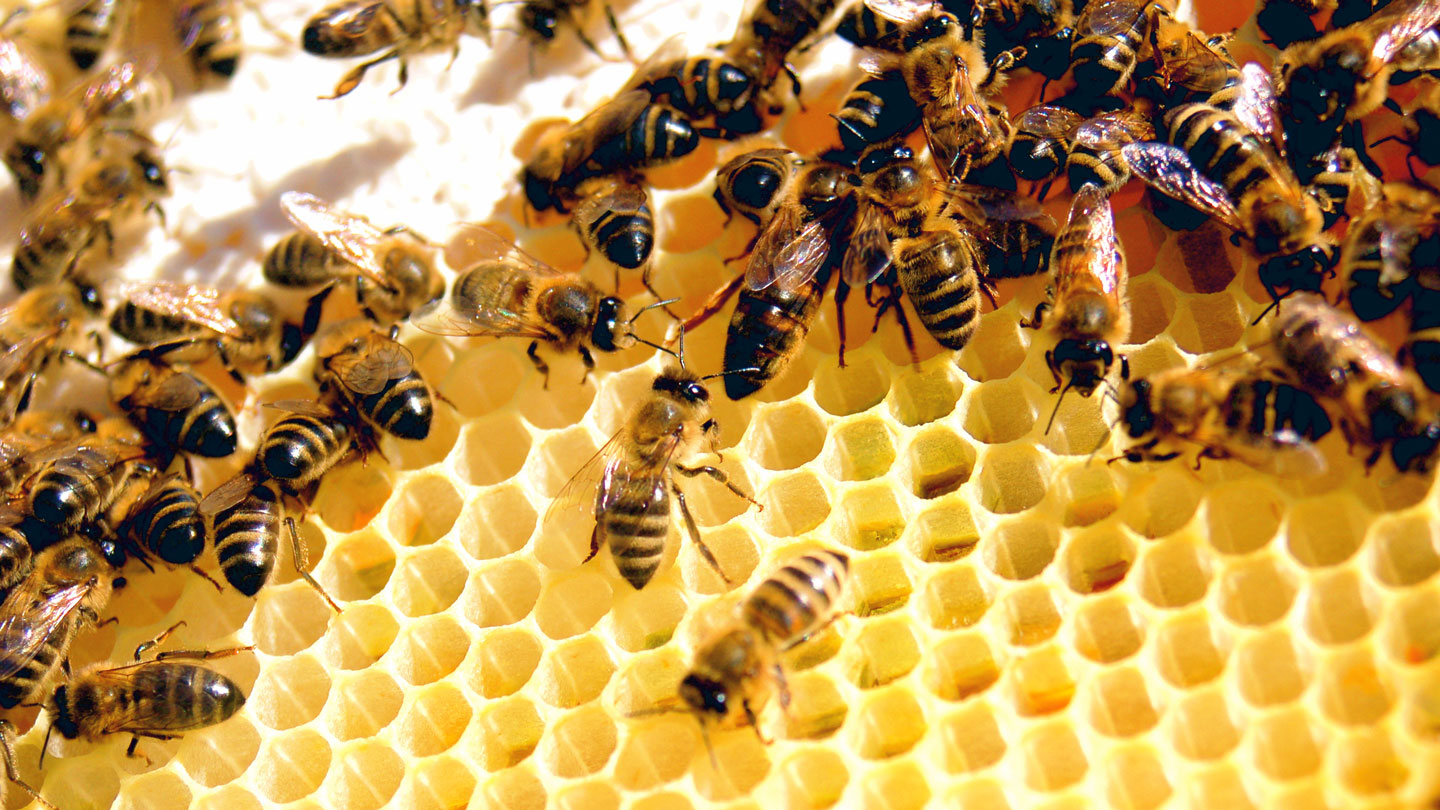Honeybees and yellow jackets don’t look much like mathematicians — for one thing, they’re smaller. But collectively, the insects can solve a common architectural conundrum using a geometric solution that they evolved independently of each other.
As their colonies grow, these bees and wasps eventually need to increase the size of the hexagonal cells that make up their nests. But nest material is expensive, and it’s hard to efficiently combine hexagons of different sizes into a single continuous array. Both the honeybees and wasps have solved this problem by mixing in some pairs of five-sided and seven-sided cells, which bridge the gap between different sizes of the six-sided hexagons, researchers report July 27 in PLOS Biology. This fix is close to the optimal solution to this problem, the team says.
“We’ve known for a long time that the hexagonal comb bees and wasps use is the most efficient, stable shape,” says Lewis Bartlett, a honeybee biologist at the University of Georgia in Athens who was not involved with the study. “But mixing different-sized hexagons is tricky.”
Social insect colonies, like those of honeybees and some wasps, are run by female workers who raise the offspring of their mother, the queen. They do this in hexagonal cells that honeybees build out of wax and wasps construct from paper (SN: 9/2/21). At a certain point in its life cycle, the colony needs to switch from raising workers to raising reproductives, like males and new queens. These reproductives are often bigger than the workers, which means the hexagonal cells need to get bigger too.
 Images of part of a honeybee nest (left) and that of two species of wasp (center, right) exhibit pairs of five- and seven-sided cells (highlighted) nestled in among the six-sided variety. The bottom of each image is oriented toward a newer part of the nest, which means these insects built the five-sided cells before the seven-sided ones to help connect smaller, older hexagonal cells (top) to larger, newer ones (bottom).M.L. Smith et al/PLOS Biology 2023Images of part of a honeybee nest (left) and that of two species of wasp (center, right) exhibit pairs of five- and seven-sided cells (highlighted) nestled in among the six-sided variety. The bottom of each image is oriented toward a newer part of the nest, which means these insects built the five-sided cells before the seven-sided ones to help connect smaller, older hexagonal cells (top) to larger, newer ones (bottom).M.L. Smith et al/PLOS Biology 2023
Images of part of a honeybee nest (left) and that of two species of wasp (center, right) exhibit pairs of five- and seven-sided cells (highlighted) nestled in among the six-sided variety. The bottom of each image is oriented toward a newer part of the nest, which means these insects built the five-sided cells before the seven-sided ones to help connect smaller, older hexagonal cells (top) to larger, newer ones (bottom).M.L. Smith et al/PLOS Biology 2023Images of part of a honeybee nest (left) and that of two species of wasp (center, right) exhibit pairs of five- and seven-sided cells (highlighted) nestled in among the six-sided variety. The bottom of each image is oriented toward a newer part of the nest, which means these insects built the five-sided cells before the seven-sided ones to help connect smaller, older hexagonal cells (top) to larger, newer ones (bottom).M.L. Smith et al/PLOS Biology 2023“Think of someone tiling your bathroom floor,” says Michael Smith, a biologist at Auburn University in Alabama. “If you have two different sizes of hexagons, and you’re going to group the small ones on one side and the big ones on the other side, you’re inherently going to have some kind of an issue when you try to fit them together.”
To figure out how bees and wasps solve this tiling puzzle, Smith and colleagues analyzed 115 images of colonies of five species of honeybee (Apis mellifera, A. cerana, A. dorsata, A. florea and A. andreniformis), four species of Vespula wasp (V. vulgaris, V. maculifrons, V. flavopilosa and V. shidai), commonly known in North America as yellow jackets, and one species of paper wasp (Metapolybia mesoamerica).
Using an automated image analysis tool developed by team member Kirstin Petersen, a roboticist at Cornell University, the scientists extracted data from 22,745 cells such as lengths of cell walls and how many neighbors each cell has. (Smith also verified the data for each one of the cells by hand. “I was the unfortunate sap,” he says, “but I was also happy to do that.”)
The automated tool allowed the team to get data from irregular cells that aren’t perfect hexagons, which many scientists had ignored due to the difficulty of measuring them manually. These seemingly misshapen cells turned out to be anything but.
When transitioning from small worker cells to big reproductive cells, all the bees and wasps built pairs of adjoining five-sided and seven-sided cells to bridge the gap. A five-seven pairing has the same number of open sides as a pair of hexagons — both types of conjoined pairs have 10 sides available to connect to other cells — so it doesn’t disrupt the pattern. And the larger size of the seven-sided cell allows the bees and wasps to seamlessly start making larger hexagons on the other side of it. “They’re always building the five-sided cell first, and then the seven-sided cell,” Smith says.
Colleague Nils Napp, a computer scientist at Cornell University, designed a mathematical model of this strategy and found that what the bees and wasps are doing is close to the optimal geometric solution.
The most efficient way to build an array of shapes such that each cell is big enough to raise a baby bee or wasp can be represented by a Delaunay triangulation. Imagine a sheet of paper marked with dozens of dots. Then, fill the sheet with triangles by connecting only neighboring dots. Finally, around each triangle, draw a circle that touches each corner. In the layout of a Delaunay triangulation, no dot is inside any of those circles. Drawing additional lines that connect centers of neighboring circles produces a tiling of polygons, much like the latticework of hexagons found in the bee and wasp nests.
Napp’s model shows that adding bigger hexagons to the nest slowly inches the whole array away from perfection, such that gaps may form or the workers may need to build an unusable cell to keep the nest together. The optimal thing to do is to add a five-seven pair just as the Delaunay condition is about to be violated. Across the bee and wasp species, about 85 percent of all nonhexagonal cells are in five-seven pairs, just like the model predicts.
The bees and wasps used in this study are separated by 179 million years of evolution and build their nests out of different materials. “But both evolved to use this five-seven rule for transitioning between hexagon sizes,” Bartlett says. “Evolution has a tendency to solve challenges optimally.”














